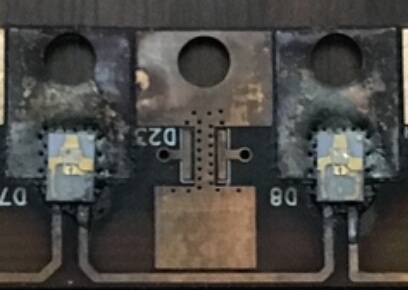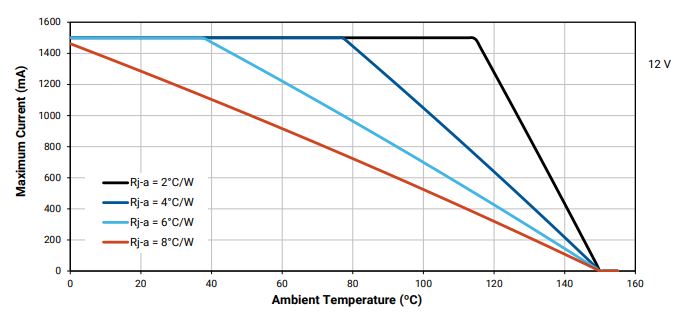Why did you select this LED. It is designed for a very specialized product, one that need a lot of lumens in a small space like a spot light or street light.
You do not have to dissipate all of the 18.375 watts (12.25V @ 1.5 A) because about 45% of the electrical power is dissipated in radiant watts (light) leaving only 55% of the electrical power to be dissipated as thermal watts (heat).
BTW you cannot run these at 12V and 1.5A. The typical Vf is 12V @ 1200 mA.
Is it a bad idea to place this on a small 2 layer breakout board? I
plan on making a ground plane on both layers, but is this still a bad
idea without a heatsink or aluminum PCB?
Yes, it is a very bad idea to use a small PCB with no heatsink.
You cannot reasonably dissipate 9 watts using the PCB surface. A small PCB with a heatsink is more cost effective.
This is a small PCB populated with Luxeon Rebel LEDs that each dissipate 1.5 Watts of heat. The PCB has backside copper and thermal vias. LEDs are spaced 0.75" apart on a 0.7" wide strip.

This LED required to be cooled with a water cooled heatsink with a sufficient volume of water per minute.
Here I attached the PCB to a copper bar and attached the bar to a copper water pipe. This was actually an inexpensive heat sink with a materials cost of about $3 per foot. Drilling the holes and mounting the copper bar was labor intensive.
I attached the bar to the LED side of the PCB to avoid inefficient thermal vias.

I used two (in case one failed) small (1 gal/minute) submersible water pumps


This is the best passive design used to cool a small PCB was a strip that is 9 mm (0.35") wide.
A 0.062" thick aluminum strip which is 1.35" wide mounted to the LED side heat spreading copper. The LEDs face down and the fins face upward. This can also be used when the LEDs and fins are facing sideways.
This 1" x 12" heatsink costs $5.

I would suggest using a lower powered LED and spread out the LEDs if possible. Lower power LEDs are more efficient where they can dissipate up to 80% of the electrical power as radiant watts.
A mid powered Samsung LM301B is almost twice as efficient as this Cree XHP50.
The most efficient high powered LED is the Cree XP-G3 but not as efficient as the mid powered LM301B which is the most efficient white LED.
The LM301Bs do not need a heatsink when driven at full power (200 mA) on a 1" wide strip.
This PCB is 100 mm x 100mm with 45 mid power LEDs which provides 1,700 lumens at 65 mA each. This board uses a total of 8 electrical watts and generates a total of about 2 thermal watts. No heatsink required.

It's about real estate. Do you really need to cram all those lumens in to a tiny area?
The pros mostly use mid power LEDs when making light bulbs:

watts are wall watts












